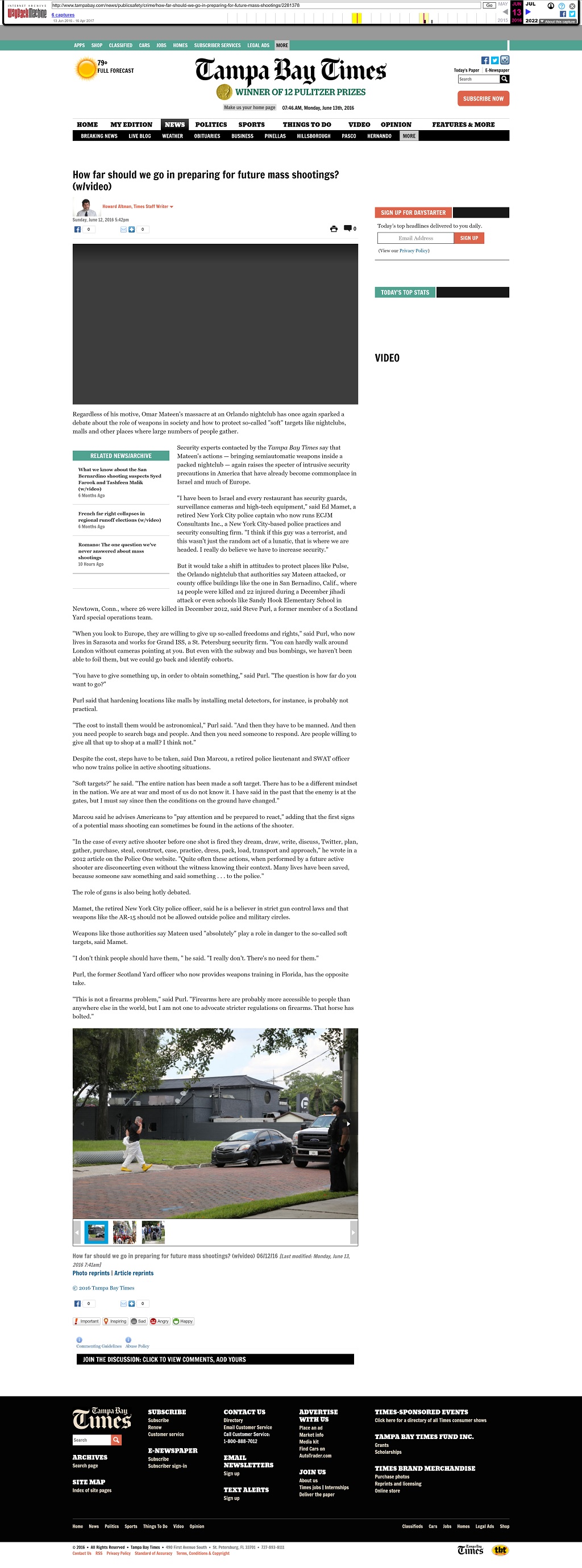
News / Public Safety
By Howard Altman / Tampa Bay Times / June 12, 2016
VIDEO:
Regardless of his motive, Omar Mateen’s massacre at an Orlando nightclub has once again sparked a debate about the role of weapons in society and how to protect so-called “soft” targets like nightclubs, malls and other places where large numbers of people gather.
Security experts contacted by the Tampa Bay Times say that Mateen’s actions — bringing semiautomatic weapons inside a packed nightclub — again raises the specter of intrusive security precautions in America that have already become commonplace in Israel and much of Europe.
“I have been to Israel and every restaurant has security guards, surveillance cameras and high-tech equipment,” said Ed Mamet, a retired New York City police captain who now runs ECJM Consultants Inc., a New York City-based police practices and security consulting firm. “I think if this guy was a terrorist, and this wasn’t just the random act of a lunatic, that is where we are headed. I really do believe we have to increase security.”
But it would take a shift in attitudes to protect places like Pulse, the Orlando nightclub that authorities say Mateen attacked, or county office buildings like the one in San Bernadino, Calif., where 14 people were killed and 22 injured during a December jihadi attack or even schools like Sandy Hook Elementary School in Newtown, Conn., where 26 were killed in December 2012, said Steve Purl, a former member of a Scotland Yard special operations team.
“When you look to Europe, they are willing to give up so-called freedoms and rights,” said Purl, who now lives in Sarasota and works for Grand ISS, a St. Petersburg security firm. “You can hardly walk around London without cameras pointing at you. But even with the subway and bus bombings, we haven’t been able to foil them, but we could go back and identify cohorts.
“You have to give something up, in order to obtain something,” said Purl. “The question is how far do you want to go?”
Purl said that hardening locations like malls by installing metal detectors, for instance, is probably not practical.
“The cost to install them would be astronomical,” Purl said. “And then they have to be manned. And then you need people to search bags and people. And then you need someone to respond. Are people willing to give all that up to shop at a mall? I think not.”
Despite the cost, steps have to be taken, said Dan Marcou, a retired police lieutenant and SWAT officer who now trains police in active shooting situations.
“Soft targets?” he said. “The entire nation has been made a soft target. There has to be a different mindset in the nation. We are at war and most of us do not know it. I have said in the past that the enemy is at the gates, but I must say since then the conditions on the ground have changed.”
Marcou said he advises Americans to “pay attention and be prepared to react,” adding that the first signs of a potential mass shooting can sometimes be found in the actions of the shooter.
“In the case of every active shooter before one shot is fired they dream, draw, write, discuss, Twitter, plan, gather, purchase, steal, construct, case, practice, dress, pack, load, transport and approach,” he wrote in a 2012 article on the Police One website. “Quite often these actions, when performed by a future active shooter are disconcerting even without the witness knowing their context. Many lives have been saved, because someone saw something and said something . . . to the police.”
The role of guns is also being hotly debated.
Mamet, the retired New York City police officer, said he is a believer in strict gun control laws and that weapons like the AR-15 should not be allowed outside police and military circles.
Weapons like those authorities say Mateen used “absolutely” play a role in danger to the so-called soft targets, said Mamet.
“I don’t think people should have them, ” he said. “I really don’t. There’s no need for them.”
Purl, the former Scotland Yard officer who now provides weapons training in Florida, has the opposite take.
“This is not a firearms problem,” said Purl. “Firearms here are probably more accessible to people than anywhere else in the world, but I am not one to advocate stricter regulations on firearms. That horse has bolted.”
PHOTO: Law enforcement officer works the perimeter in the rear of Pulse nightclub where Omar Mateen opened fire killing 50 people and injuring others on Sunday morning. (DOUG CLIFFORD | Times)
PHOTO: The Tampa Pride Street Festival and Parade rolls along Ybor City’s Seventh Avenue in March. Parades are “soft targets’’ that are difficult to keep secure. (LUIS SANTANA | Times)
PHOTO: Law enforcement officers stand near the Pulse nightclub where Omar Mateen opened fire killing 50 people and injuring others on Sunday morning, June 12, 2016. (DOUG CLIFFORD | Times)
Wayback image

